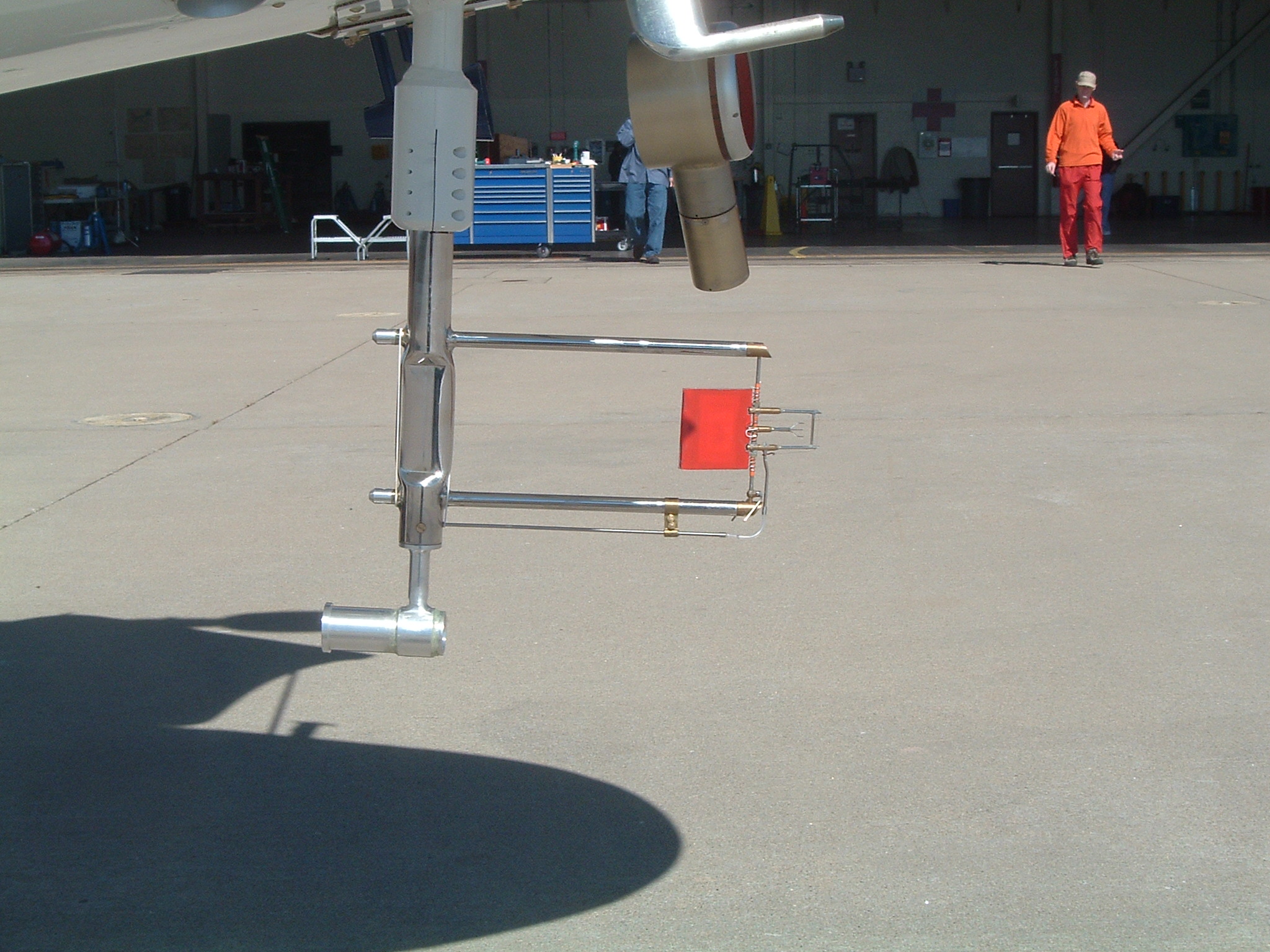Research group
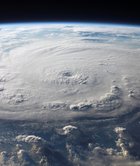
Cloud dynamics and atmospheric turbulence
Atmospheric Physics Department
We study the dynamics of clouds in the full range of scales from the movement of individual droplets to flows in scale of clouds and cloud systems. We focus on the phenomenon of turbulence and (direct and indirect) influence of small- and moderate- scale turbulence in clouds and surrounding atmosphere on larger scale flows like weather patterns and even general circulation.
One of our experimental achievements is the Ultra Fast Thermometer, an airborne sensor to measure temperature in clouds. The instrument is in constant development since the early nineties. With recent versions we are able to measure temperature in clouds with 5 mm resolution.
|
Ultra Fast Thermometer UFT-M mounted on CIRPAS Twin Otter in the course of POST research campaign |
Example of numerical simulation:
Animations of droplets motion in the idealized vortical flow
The motion of cloud droplets in a very strong vortex, a model of the smallest structure in small turbulent flow was numerically simulated. The aim was theoretical reproduction and understanding of the phenomenon called „cloud voids” („Swiss cheese” clouds), observed at the mountain meteorological and environmental laboratory at the Zugspitze summit in Germany.
At the cylindrical edge of a stationary (not changing in time) Burgers vortex stretching, cloudloud droplets are randomly added. Their initial velocity corresponds to the radial component of the vortex velocity field, their motion is then governed by gravity and interaction with the flow. Thus, the equation of motion of a single drop, the Stokes viscosity force, and the force of gravity are taken into account. Virtual droplets in the virtual flow do not collide, they also no influence the fluid flow. The droplet size distribution is similar to the observed one, whilst the color and the size in the animation reflect the intensity of the Mie scattering of the green laser light used in the experiment. The vortex axis is inclined relative to the direction of gravity. Trajectories of droplets in this system show existence of various attractors in the plane perpendicular to the vortex axis: limit cycles and different equilibrium points, stable and unstable. The three presented animations illustrate selected examples of vortex parameters for which the droplets show quite different behavior.
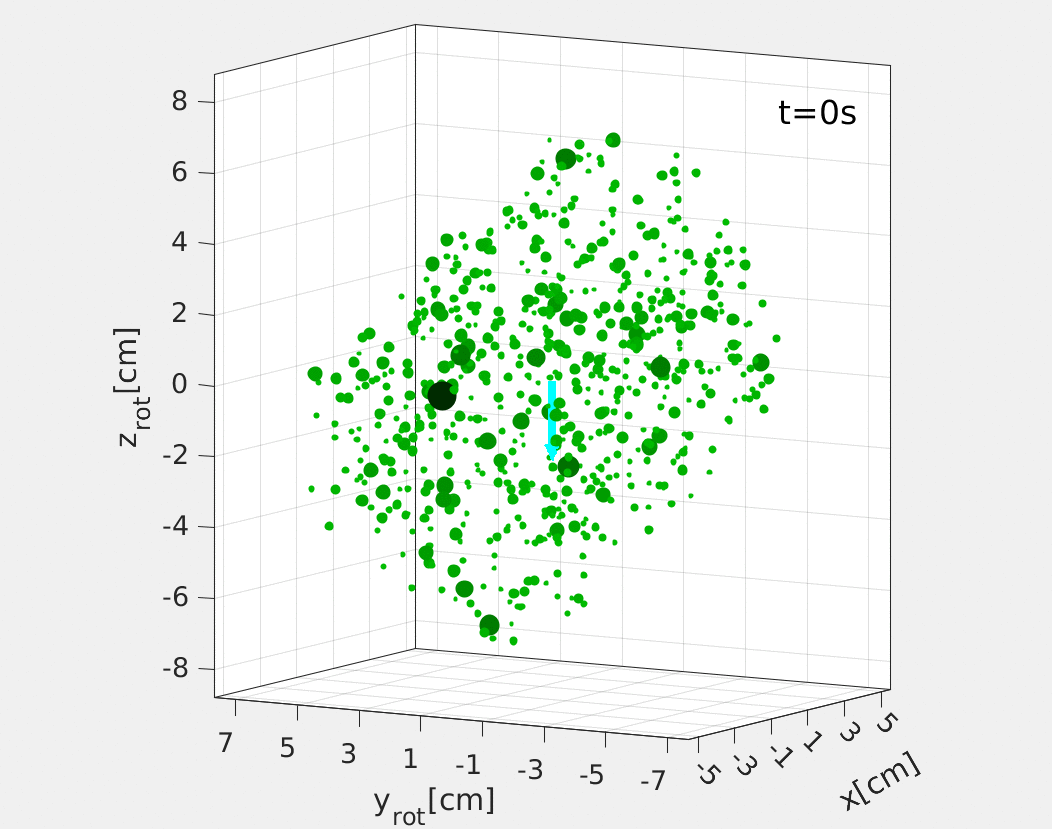 |
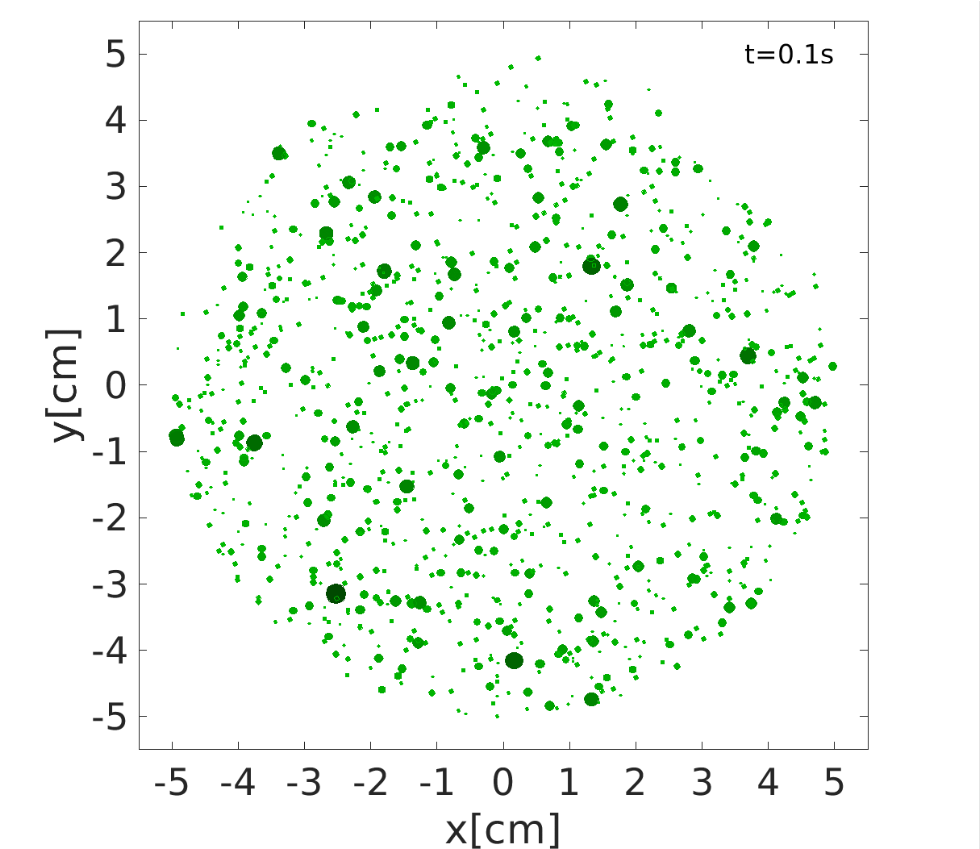 |
Animation 1: no voids are present in the droplet field. | ||
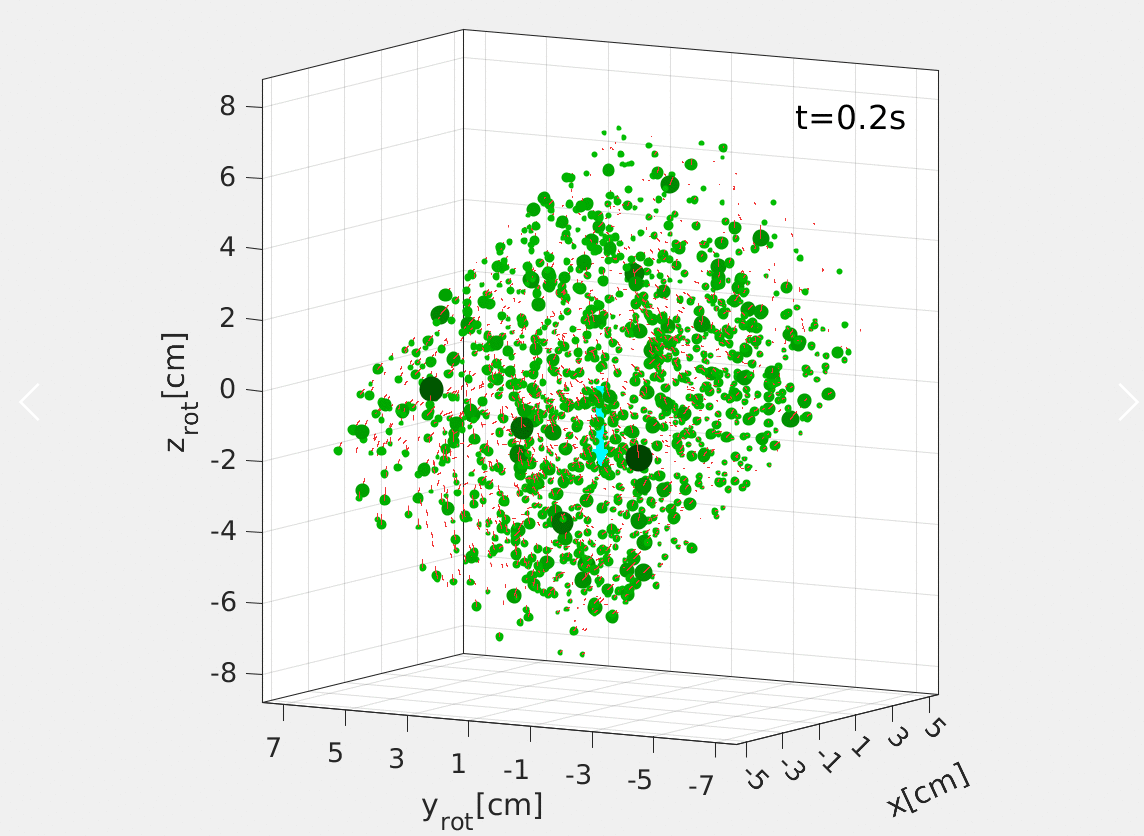 |
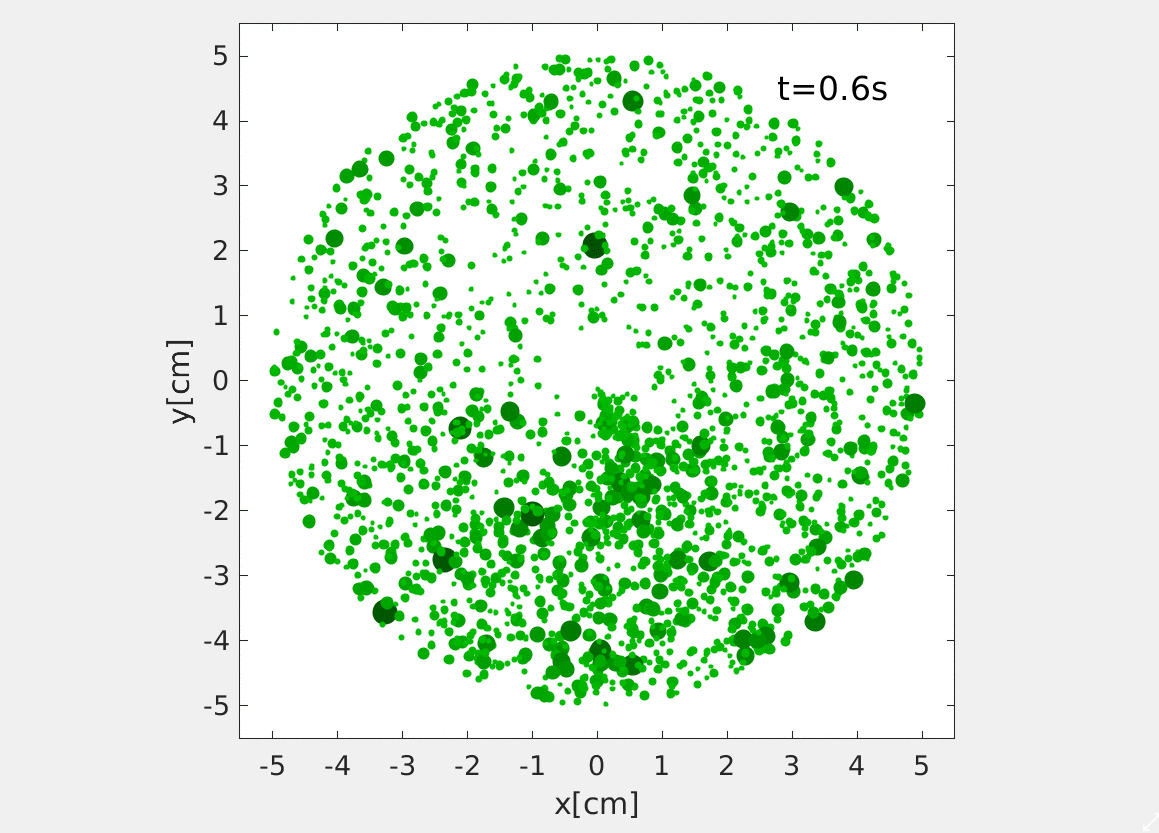 |
Animation 2: the void is present but in a "fuzzy" condition. | ||
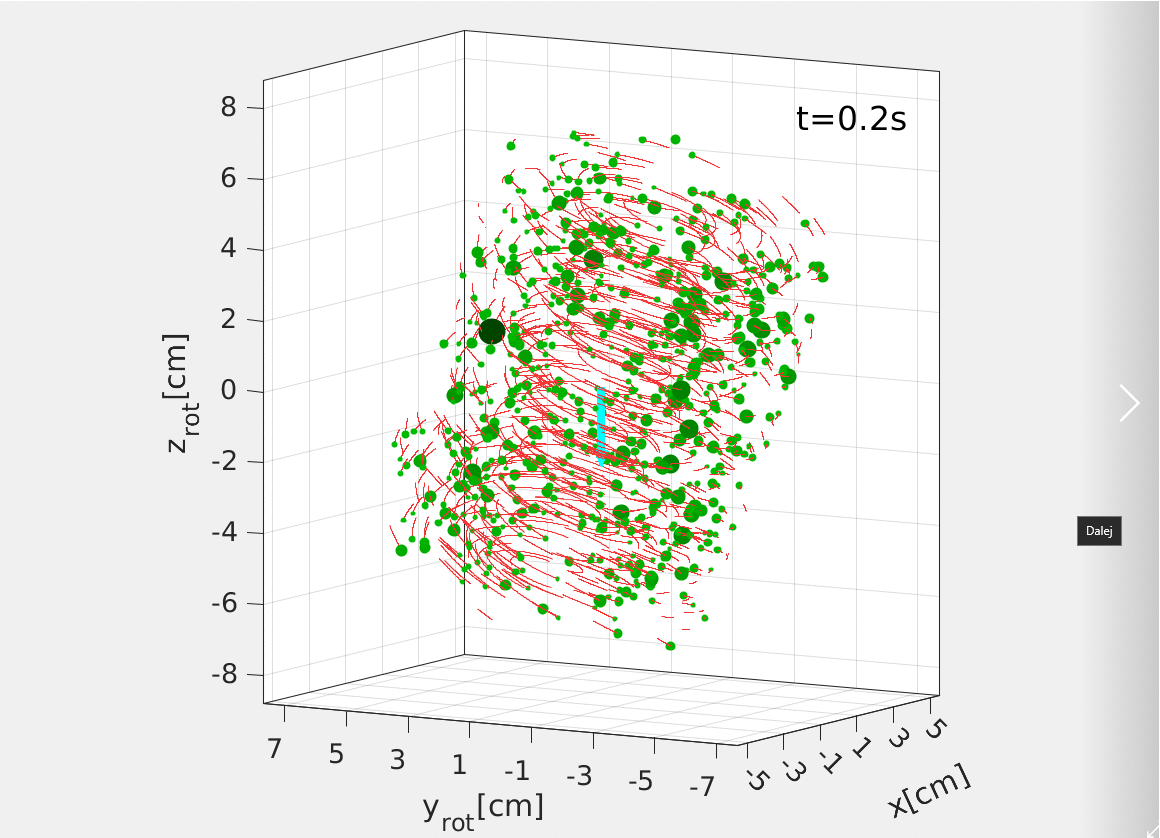 |
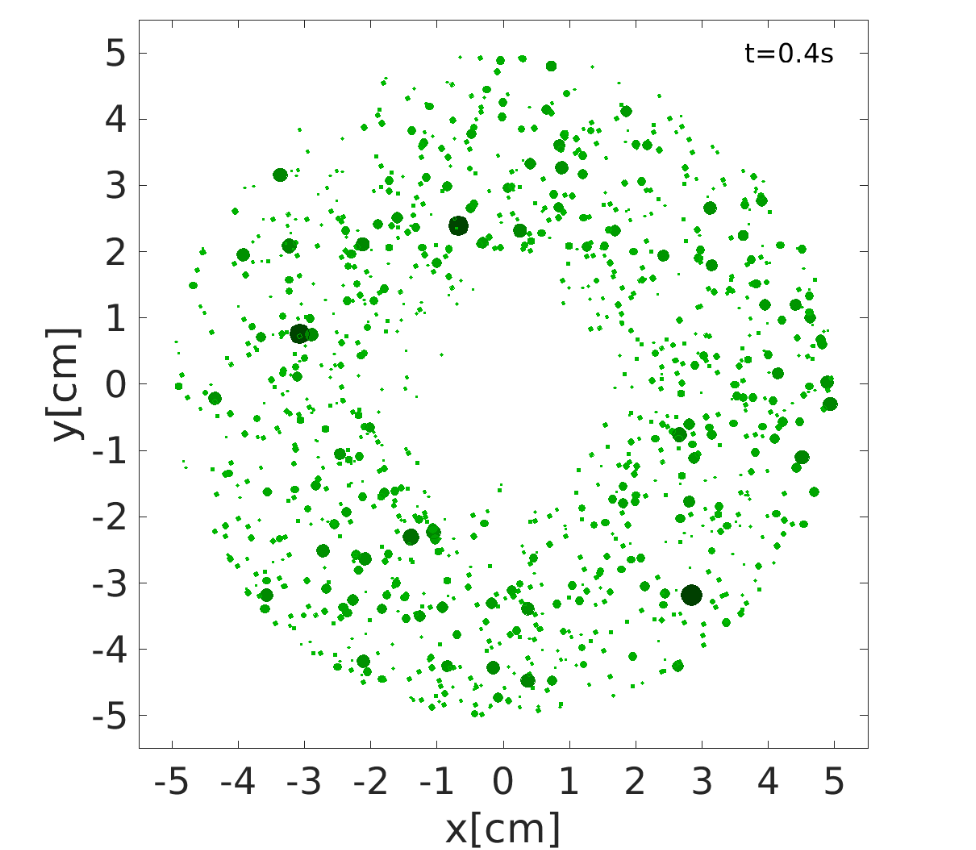 |
Animation 3: the void is clearly visible |
These simulations allow us to conclude about intensive clustering and possible large impact on the probability of droplet collisions in strong vortex tubes in real clouds.
Research project
-
Next Generation Earth Modelling Systems (NextGEMS)
Source of financing: EC, HORIZON 2020
Realisation period: Sept. 1, 2021–Aug. 31, 2025
-
Particle fluxes in urban environment with remote sensing (PURER-SENS)
Source of financing: NCN, SONATINA
Realisation period: Oct. 1, 2021–Sept. 30, 2023
-
High resolution temperature measurements: investigations of ocean-atmosphere turbulent exchange in the course of EUREC4A-ATOMIC campaign.
Source of financing: NCN, HARMONIA
Realisation period: April 17, 2019–April 16, 2023
-
Mikrodynamika chmur
Source of financing: NCN, MAESTRO
Realisation period: Aug. 28, 2013–Aug. 27, 2019
-
Numerical modeling of cloud microphysics and microphysics-dynamics interactions in shallow boundary-layer clouds
Source of financing: NCN, POLONEZ
Realisation period: Oct. 1, 2016–Sept. 30, 2017
-
Psychrometr samolotowy i optyczna detekcja pary wodnej
Source of financing: MNiSW
Realisation period: May 18, 2011–Aug. 31, 2015
-
Study of Air-Sea interaction and Cloud parameterizations in suport of parameterization development for global mesoscale models at NRL Monterey
Source of financing: ONR
Realisation period: Feb. 10, 2010–Feb. 11, 2014
-
Badania oddziaływań miedzy atmosfera a oceanem oraz parametryzacji chmur na potrzeby rozwoju globalnych modeli mezoskalowych w NRL Monterey
Source of financing: MNiSW
Realisation period: Feb. 10, 2010–Feb. 11, 2014
-
EUFAR - European Fleet for Airborne Research in Environmental and Geoscience
Source of financing: EC, 7th Framework Programme
Realisation period: Oct. 8, 2008–Sept. 30, 2013
-
Unmanned aerial systems (UAS) in atmospheric research
Source of financing: COST
Realisation period: June 18, 2008–May 19, 2013
-
POST - Collaborative Reserch: Physics of Stratocumulus Top
Source of financing: NSF
Realisation period: Jan. 1, 2008–Feb. 28, 2009
-
Metodyka generacji regionalnych bred wektorów dla obszaru Polski dla potrzeb prognozowania pogody metodą wiązek
Source of financing: MNiSW
Realisation period: May 5, 2006–May 4, 2008
-
Badanie spektralnych właściwości optycznych aerozolu oraz wymuszania radiacyjnego
Source of financing: KBN
Realisation period: Nov. 8, 2004–Nov. 7, 2007
-
Validation and Data Assimilation for the Navy Transport Models: NAAPS and COAMPS/transport, NICOM
Source of financing: ONR
Realisation period: Oct. 11, 2004–Oct. 11, 2007
-
Numeryczny niehydrostatyczny model procesów atmosferycznych w małych i średnich skalach
Source of financing: KBN
Realisation period: Oct. 11, 2001–Oct. 11, 2003
-
Wpływ procesów falowych w atmosferze na strukturę planetarnej warstwy granicznej
Source of financing: KBN, Promotorski
Realisation period: Oct. 11, 2000–Oct. 11, 2001
-
Wpływ wirów na gradient temperatury oraz koncentrację unoszonych cząstek
Source of financing: MNiI
Realisation period: Sept. 10, 1999–Sept. 30, 2001
-
Drobnoskalowe mieszanie turbulencyjne w chmurach: badania eksperymentalne i modelowanie numeryczne
Source of financing: KBN
Realisation period: Oct. 11, 1997–Oct. 11, 1999
-
PRESTO Precision Weather Forecast System for Different Types of Transport
Source of financing: EC, 4th Framework Programme
Realisation period: Oct. 11, 1997–Oct. 11, 1999
-
Struktura i dynamika wirów oraz ich zastosowania do opisu przepływów turbulentnych
Source of financing: MNiI
Realisation period: March 15, 1997–March 14, 1999
-
Eksperymentalne i teoretyczne badania oddziaływań międzyskalowych w chmurach
Source of financing: KBN
Realisation period: Oct. 11, 1995–Oct. 11, 1998
-
Empiryczne badania smug chłodniowych i kominowych Elektrowni Bełchatów
Source of financing: KPRM, Rządowy Program Badawczo-Rozwojowy, http://cordis.europa.eu/data/PROJ_FP5/ACTIONeqDndSESSIONeq112362005919ndDOCeq288ndTBLeqEN_PROJ.htm
Realisation period: Oct. 11, 1983–Oct. 11, 1988
Research & Organizational Project
-
ATMO ACCESS - Solutions for Sustainable Access to Atmospheric Research Facilities
Source of financing: EC, HORIZON 2020
Realisation period: April 1, 2021–March 31, 2025
Field Experiment
-
BBC2 - Baltex Bridge Cloud campaign
Realisation period: Oct. 11, 2003–Oct. 11, 2003
| prof. dr hab. Szymon P. Malinowski |
| dr inż. Marta Wacławczyk | |
| mgr Katarzyna Karpińska | |
| mgr Moein Mohammadi | |
| dr Jakub Nowak | |
| mgr inż. Stanisław Król | |
| mgr Robert Grosz |
- Akinlabi E.O., Wacławczyk M., Mellado J.P., and Malinowski S.P., 2019, Estimating Turbulence Kinetic Energy Dissipation Rates in the Numerically Simulated Stratocumulus Cloud-Top Mixing Layer: Evaluation of Different Methods, Journal of the Atmospheric Sciences, vol. 76(5), 1471–1488, 10.1175/JAS-D-18-0146.1
- Ma Y.-F., Pedersen J.G., Grabowski W.W., Kopec M.K., Malinowski S.P., 2018, Influences of Subsidence and Free‐Tropospheric Conditions on the Nocturnal Growth of Nonclassical Marine Stratocumulus, Journal of Advances in Modeling Earth Systems, vol. 10(11), 2706-2730, 10.1029/2018MS001295
- Pedersen J.G., Ma Y-F., Grabowski W.W., Malinowski S.P., 2018, Anisotropy of Observed and Simulated Turbulence in Marine Stratocumulus, Journal of Advances in Modeling Earth Systems, vol. 10(2), 500-515, 10.1002/2017MS001140
- Popkiewicz M, Kardaś A., Malinowski S., 2018, Nauka o klimacie
- Stacewicz T., Magryta P., Petersen B., Nowak J., Kwiatkowski K., Malinowski S., 2018, Highly sensitive airborne open path optical hygrometer for upper air measurements - proof of concept, Metrology and Measurement Systems, vol. 25(4), 793–805, 10.24425/mms.2018.124877
- The EARLINET publishing group 2000-2015; 129 authors, a.o. Stachlewska I.S., Szczepanik D.,, 2018, EARLINET (A European Aerosol Research Lidar Network to Establish an Aerosol Climatology). EARLINET All 2000-2015 Data Collection, World Data Center for Climate (WDCC) at DKRZ, 10.1594/WDCC/EARLINET_All_2000-2015
- Vinayachandran P.N., Matthews A.J., Kumar K.V., Sanchez-Franks A., Thushara V., George J., Vijith V., Webber B.G.M., Queste B.Y., Roy R., Sarkar A., Baranowski D.B., Bhat G.S., Klingaman N.P., Peatman S.C., Parida C., Heywood K.J., Hall R., King B., Kent E.C., Nayak A.A., Neema C.P., Amol P., and, 2018, BoBBLE: Ocean–Atmosphere Interaction and Its Impact on the South Asian Monsoon, Bulletin of the American Meteorological Society, vol. 75(10), 3365–3379, 10.1175/BAMS-D-16-0230.1
- Ma Y.-F., Malinowski S.P., Karpińska K., Gerber H.E. and Kumala W., 2017, Scaling Analysis of Temperature and Liquid Water Content in the Marine Boundary Layer Clouds during POST, Journal of the Atmospheric Sciences, vol. 74 (12), 4075–4092, 10.1175/JAS-D-17-0015.1
- Wacławczyk M., Ma Y., Kopec J.M., and Malinowski S.P., 2017, Novel approaches to estimating the turbulent kinetic energy dissipation rate from low- and moderate-resolution velocity fluctuation time series, Atmospheric Measurement Techniques, vol. 10, 4573-4585, 10.5194/amt-10-4573-2017
- Gerber H., Malinowski S.P., and Jonsson H., 2016, Evaporative and Radiative Cooling in POST Stratocumulus, Journal of the Atmospheric Sciences, vol. 73, 3877–3884, 10.1175/JAS-D-16-0023.1
- Jen-La Plante I., Ma Y., Nurowska K., Gerber H., Khelif D., Karpinska K., Kopec M.K., Kumala W., Malinowski S.P., 2016, Physics of Stratocumulus Top (POST): turbulence characteristics, Atmospheric Chemistry and Physics, vol. 16, 9711-9725, 10.5194/acp-16-9711-2016
- Kopec M., Malinowski S., Piotrowski Z., 2016, Effects of wind shear and radiative cooling on the stratocumulus-topped boundary layer, Quarterly Journal of the Royal Meteorological Society, vol. 142 (701), 3222–3233, 10.1002/qj.2903
- Nowak J., Magryta P., Stacewicz T., Kumala W., Malinowski S.P., 2016, Fast optoelectronic sensor of water concentration, Optica Applicata, vol. 46(4), 607-618, 10.5277/oa160408
- Pedersen J.G., Malinowski S.P., Grabowski W.W., 2016, Resolution and domain-size sensitivity in implicit large-eddy simulation of the stratocumulus-topped boundary layer, Journal of Advances in Modeling Earth Systems, vol. 8, 885–903, 10.1002/2015MS000572
- Siebert, H., Shaw, R. A., Ditas, J., Schmeissner, T., Malinowski, S.P., Bodenschatz, E. and Xu, H., 2015, High-resolution measurement of cloud microphysics and turbulence at a mountaintop station, Atmospheric Measurement Techniques, vol. 8, 3219-3228, 10.5194/amt-8-3219-2015
- Jakubiak, B., Licznar, P., Malinowski, S.P., 2014, Rainfall estimates from radar vs. raingauge measurements. Warsaw case study, Environment Protection Engineering, vol. 40 (2), 159-170, doi: 10.5277/epe140212
- Karpinska K., Malinowski S.P., 2014, Towards better understanding of preferential concentration in clouds: droplets in small vortices, American Meteorological Society 14th Conference on Cloud Physics/14th Conference on Atmospheric Radiation, At Boston, MA, USA, doi: 10.13140/2.1.4434.9445
- Stacewicz, T., Posyniak, M., Sitarek, S., Malinowski, S.P., 2014, Lidar retrievals of cloud droplet number concentration at the cumulus base: A feasibility study, Atmospheric Research, vol. 142, 32-39, 10.1016/j.atmosres.2013.10.023
- Bange, J., Esposito, M., Lenschow, D.H., Brown, P.R.A., Dreiling, V., Giez, A., Mahrt, L., Malinowski, S.P., Rodi, A.R., Shaw, R.A., Siebert, H., Smit, H., Zöger, M., 2013, Measurement of Aircraft State and Thermodynamic and Dynamic Variables, Airborne Measurements for Environmental Research: Methods and Instruments, vol. 1, 7-75, 10.1002/9783527653218.ch2
- Gerber H., Frick G., Malinowski S.P., Jonsson H., Khelif D., Krueger S.K., 2013, Entrainment rates and microphysics in POST stratocumulus, Journal of Geophysical Research, vol. 118 (21), 12,094–12,109, 10.1002/jgrd.50878
- Kumala, W., Haman, K. E., Kopec, M. K., Khelif, D., and Malinowski, S. P., 2013, Modified ultrafast thermometer UFT-M and temperature measurements during Physics of Stratocumulus Top (POST), Atmospheric Measurement Techniques, vol. 3, 2043-2054, 10.5194/amt-6-2043-2013, 2013
- Malinowski S.P., Gerber H., Jen-La Plante I., Kopec M.K., Kumala W., Nurowska K., Chuang P.Y., Khelif D., Haman K.E., 2013, Physics of Stratocumulus Top (POST): turbulent mixing across capping inversion, Atmospheric Chemistry and Physics, vol. 13, 12171-12186, 10.5194/acp-13-12171-2013
- Muhlbauer A., Grabowski W.W., Malinowski S.P., Ackerman T., Bryan G., Lebo Z., Milbrandt J., Morrison H., Ovchinnikov M., Tessendorf S., Thériault J., Thompson G., 2013, Reexamination of the State of the Art of Cloud Modeling Shows Real Improvements, Bulletin of the American Meteorological Society, vol. 94 (5), ES45-ES48, 10.1175/BAMS-D-12-00188.1
- Devenish, B.J., Bartello, P., Brenguier, J.-L., Collins, L.R., Grabowski, W.W., Ijzermans, R.H.A., Malinowski, S.P., Reeks, M.W., Vassilicos, J.C., Wang, L.-P., Warhaft, Z., 2012, Droplet growth in warm turbulent clouds, Quarterly Journal of the Royal Meteorological Society, vol. 138, 1401–1429, 10.1002/qj.1897
- Korczyk P.M., Kowalewski T.A., Malinowski S.P., 2012, Turbulent mixing of clouds with the environment: Small scale two phase evaporating flow investigated in a laboratory by particle image velocimetry, Physica D: Nonlinear Phenomena, vol. 241 (3), 288-296, 10.1016/j.physd.2011.11.003
- Markowicz, K.M., Zielinski, T., Blindheim, S., Gausa, M., Jagodnicka, A.K., Kardas, A.E., Kumala, W., Malinowski, S.P., Petelski, T., Posyniak, M., Stacewicz T., 2012, Study of vertical structure of aerosol optical properties with sun photometers and ceilometer during MACRON campaign in 2007, Acta Geophysica, vol. 60 (5), 1308–1337, 2478/s11600-011-0056-7
- Baranowski, D.B., Flatau, P.J., Malinowski, S.P., 2011, Tropical cyclone turbulent mixing as observed by autonomous oceanic profilers with the high repetition rate, Journal of Physics: Conference Series, vol. 318(SECTION 7), 3072001, 10.1088/1742-6596/318/7/072001
- Malinowski, S.P., Haman, K.E., Kopec, M.K., Kumala, W., Gerber, H., 2011, Small-scale turbulent mixing at stratocumulus top observed by means of high resolution airborne temperature and LWC measurements, Journal of Physics: Conference Series, vol. 318(SECTION 7), 072013, doi:10.1088/1742-6596/318/7/072013
- Malinowski, Sz.P., Wyszogrodzki, A.A., Ziemiański, M.Z., 2011, Modeling Atmospheric Circulations with Sound-Proof Equations, Acta Geophysica, vol. 59 (6), 1073-1075, 10.2478/s11600-011-0057-6
- Posyniak, M., Malinowski, S.P., Stacewicz, T., Markowicz K.M., Zieliński T., Petelski, T., Makuch, P., 2011, Multiwavelength micropulse lidar in atmospheric aerosol study - Signal processing, Proceedings of SPIE - The International Society for Optical Engineering, vol. Lidar Technologies, Techniques, and Measurements for Atmospheric Remote Sensing VII, 818216, 10.1117/12.898160
- Bodenschatz E., Malinowski S.P., Shaw R.A., Strattmann F., 2010, Can We Understand Clouds without Turbulence?, Science, vol. 327, 970-971, 10.1126/science.1185138
- Kardaś, A.E, Markowicz, K.M., Stelmaszczyk, K., Karasinski, G., Malinowski, S.P., Stacewicz, T., Woeste, L., Hochhertz, C., 2010, Saharan aerosol sensed over Warsaw by depolarization lidar, Optica Applicata, vol. 40, 219-237
- Posyniak, M., Stacewicz, T., Miernecki, M., Jagodnicka, A.K., Malinowski S.P., 2010, Multiwavelength micropulse lidar for atmospheric aerosol investigation, Optica Applicata, vol. 40, 623-632
- Andrejczuk M., Grabowski W.W., Malinowski S.P., Smolarkiewicz P.K., 2009, Numerical Simulation of Cloud-Clear Air Interfacial Mixing:Homogeneous versus Inhomogeneous Mixing, Journal of the Atmospheric Sciences, 2493-2500, 10.1175/2009JAS2956.1
- Jagodnicka, A.K., Stacewicz, T. Karasiński, G., Posyniak, M., Malinowski S.P., 2009, Particle size distribution retrieval from multiwavelength lidar signals for droplet aerosol, Applied Optics, vol. 48, B8-B16, 10.1364/AO.48.0000B8
- Jagodnicka, A.K., Stacewicz, T., Posyniak, M., Malinowski, S.P., 2009, Aerosol investigation with multiwavelength lidar, Proceedings of SPIE - The International Society for Optical Engineering, vol. 7479, Lidar Technologies, Techniques, and Measurements for Atmospheric Remote Sensing V, 747903, 10.1117/12.830465
- Kardas, A.E., McFarlane, S., Morrison, H., Comstock J., Grabowski, W.W., Malinowski, S.P., 2009, The radar simulator: Deriving the radar signal using the cloud model output, Proceedings of SPIE - The International Society for Optical Engineering, vol. 7475, Remote Sensing of Clouds and the Atmosphere XIV, 74751M, 10.1117/12.830100
- Kurowski, M.J., Malinowski, S.P., Grabowski, W.W., 2009, A numerical investigation of entrainment and transport within a stratocumulus-topped boundary layer, Quarterly Journal of the Royal Meteorological Society, vol. 135, 77–92, 10.1002/qj.354
- Piotrowski, Z.P., Smolarkiewicz, P.K, Malinowski, S.P., Wyszogrodzki A.A., 2009, On numerical realizability of thermal convection, Journal of Computational Physics, vol. 228, 6268-6290, 10.1016/j.jcp.2009.05.023
- Falkovich G., Malinowski S.P., 2008, Focus on Cloud Physics, New Journal of Physics, vol. 10
- Malinowski, S.P., Andrejczuk, M., Grabowski, W.W., Korczyk P.K., Kowalewski T.A., Smolarkiewicz P.K., 2008, Laboratory and modeling studies of cloud-clear air interfacial mixing: anisotropy of small-scale turbulence due to evaporative cooling, New Journal of Physics, vol. 10, 075020, 10.1088/1367-2630/10/7/075020
- Haman K.E., Malinowski S.P., Kurowski M.J., Gerber H., Brenguier, J.L., 2007, Small scale mixing processes at the top of a marine stratocumulus – a case study, Quarterly Journal of the Royal Meteorological Society, vol. 133, 213-226, 10.1002/qj.5
- Karasiński, G., Kardaś, A. E., Markowicz, K.M., Malinowski, S.P., Stacewicz, T., Stelmaszczyk, K., Chudzyński, S., Skubiszak, W., Posyniak, M., Jagodnicka, A. K., Hochhertz, C., Woeste, L., 2007, Lidar investigation of properties of atmospheric aerosol, European Physical Journal Special Topics, vol. 144, 129–138, 10.1140/epsjst/e2007-00117-8
- Andrejczuk M., Grabowski W.W., Malinowski S.P., Smolarkiewicz P.K., 2006, Numerical simulation of cloud-clear air interfacial mixing: effects on cloud microphysics, Journal of the Atmospheric Sciences, vol. 63, 3204–3225, 10.1175/JAS3813.1
- Korczyk P.M., Malinowski S.P., Kowalewski T.K., 2006, Mixing of cloud and clear air in centimeter scales observed in laboratory by means of particle image velocimetry, Atmospheric Research, vol. 82, 173-182, 10.1016/j.atmosres.2005.09.009
- Gerber, H., Frick G., Malinowski S.P., Brenguier J.L., Burnet F., 2005, Holes and Entrainment in Stratocumulus, Journal of the Atmospheric Sciences, vol. 62, 443–459, 10.1175/JAS-3399.1
- Jaczewski A., Malinowski S.P., 2005, Spatial distribution of cloud droplets investigated in a turbulent cloud chamber, Quarterly Journal of the Royal Meteorological Society, vol. 131, 2047-2062, 10.1256/qj.04.65
- Andrejczuk M., Grabowski W.W., Malinowski S.P., Smolarkiewicz P.K., 2004, Numerical Simulation of Cloud-Clear Air Interfacial Mixing, Journal of the Atmospheric Sciences, vol. 61, 1726–1739, 10.1175/1520-0469(2004)061<1726:NSOCAI>2.0.CO;2
- Stevens B., Lenschow D.H., Vali G., Gerber, H, Bandy, A., Blomquist, B., Brenguier, J.L., Bretherton, C.S., Burnet, F., Campos, T. Chai, S., Faloona, I., Friesen, D., Haimov, S., Laursen, K. Lilly, D.K., Loehrer, S.M., Malinowski, S.P., Morley, B, Petters, M.D., Rogers, D.C., Russell, L., Savic-Jovac, V., Snider, J.R., Straub, D., Szumowski, M.J., Takagi, H. Thornton, D.C. Tschudi, M., Twohy, C., Wetzel, M., van Zanten, M.C., 2003, Dynamics and chemistry of marine stratocumulus – Dycoms-II, Bulletin of the American Meteorological Society, vol. 84, 579-593, 10.1175/BAMS-84-5-579
- Haman K.E., Malinowski S.P., Strus B.D., Busen R., Stefko A., 2001, Two new types of ultrafast aircraft thermometers, Journal of Atmospheric and Oceanic Technology, vol. 18, 117-134, 10.1175/1520-0426(2001)018<0117:TNTOUA> 2.0.CO;2
- Banat P., Malinowski S.P., 1999, Properties of the turbulent cloud-clear air interface observed in the laboratory experiment, Physics and Chemistry of the Earth B, vol. 24, 741-745, 10.1016/S1464-1909(99)00075-1
- Malinowski S.P., Jaczewski A., 1999, Laboratory investigation of droplet concentration at the cloud-clear air interface, Physics and Chemistry of the Earth B, vol. 24, 477-480, 10.1016/S1464-1909(99)00032-5
- Malinowski S.P., Zawadzki I., Banat P., 1997, Laboratory Observations Of Cloud-Clear Air Mixing at Small Scales, Journal of Atmospheric and Oceanic Technology, vol. 15, 1060-1065, 10.1175/1520-0426(1998)015<1060:LOOCCA>2.0.CO;2
- Haman, K.E., Malinowski, S.P., 1988, Observations of cooling tower and stack plumes and their comparison with plume model "ALINA", Atmospheric Environment, vol. 23(6), 1223-1234, doi.org/10.1016/0004-6981(89)90149-2
| dr Dariusz Baranowski |
|
| dr Jesper G. Pedersen |
|
| dr Yongfeng Ma |
|
| mgr Emmanuel Akinlabi |
|
| mgr Anna Górska |
|
| mgr Marta Kopeć |
|
| mgr Jacek Kopeć |
|

